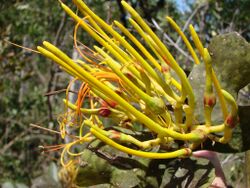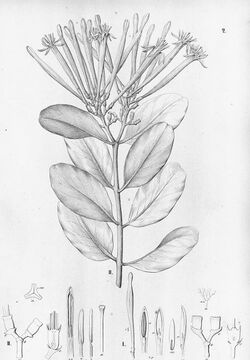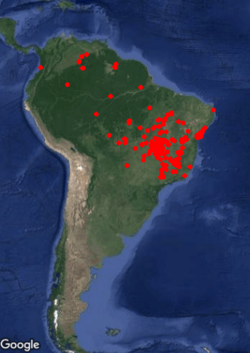Biology:Psittacanthus robustus
| Psittacanthus robustus | |
|---|---|

| |
| Psittacanthus robustus | |

| |
| Scientific classification | |
| Kingdom: | Plantae |
| Clade: | Tracheophytes |
| Clade: | Angiosperms |
| Clade: | Eudicots |
| Order: | Santalales |
| Family: | Loranthaceae |
| Genus: | Psittacanthus |
| Species: | P. robustus
|
| Binomial name | |
| Psittacanthus robustus | |

| |
| collections data from GBIF[2] | |
| Synonyms | |
| |
Psittacanthus robustus is a species of Neotropical mistletoe in the family Loranthaceae, which is found in Brazil , Colombia, Guyana, and Venezuela.[4]
Description
Initially, branches are erect, but adult branches are pendulous.[3] Branch cross-sections are square.[3] Leaves are petiolate and obtuse at both base and apex.[3] Inflorescences are both terminal and axillary, consisting of umbels of yellow to orange triads (flowers in groups of three).[3] The fruit is light green colored when immature but when ripe the colour changes to black, and looks somewhat like an olive.[5] Its seeds have 3 cotyledons and sticky substance inside.[5]
Taxonomy
P. robustus was first described by Martius in 1829 as Loranthus robustus,[6][7] and in 1830, he assigned it to a new genus Psittacanthus.[1][8]
Distribution
It has been found in the Northern Amazon, in Brazil North, Brazil Northeast, Brazil Southeast, Brazil West-Central, Colombia, Guyana, and Venezuela,[4] in Amazonian rainforests, Caatinga, the Central Brazilian Savanna, and the Atlantic Rainforest.[3]
Ecology
Three species of birds have been found eating and excreting the seeds. The most common isTersina viridis viridis (swallow tanager), but also the cinnamon-tanager, Schystoclamys ruficapillus ruficapillus, and the sayaca-tanager, Thraupis sayaca sayaca.[5]
It has been found on thirteen hosts, from the genera Vochysiaceae and Melastomaceae.[5]
References
- ↑ Jump up to: 1.0 1.1 "IPNI: Psittacanthus robustus". International Plant Names Index. http://www.ipni.org/ipni/idPlantNameSearch.do?id=551439-1. Retrieved 19 May 2018.
- ↑ GBIF.org (19 May 2018) GBIF Occurrence Download https://doi.org/10.15468/dl.rzldkq
- ↑ Jump up to: 3.0 3.1 3.2 3.3 3.4 3.5 "Psittacanthus robustus (Mart.) Mart.". Flora do Brasil 2020: Algae, Fungi, Plants, Jardim Botânico do Rio de Janeiro. http://reflora.jbrj.gov.br/reflora/listaBrasil/ConsultaPublicaUC/BemVindoConsultaPublicaConsultar.do?invalidatePageControlCounter=1&idsFilhosAlgas=%5B2%5D&idsFilhosFungos=%5B1%2C10%2C11%5D&lingua=&grupo=5&familia=152&genero=Psittacanthus&especie=robustus&autor=&nomeVernaculo=&nomeCompleto=&formaVida=null&substrato=null&ocorreBrasil=QUALQUER&ocorrencia=OCORRE&endemismo=TODOS&origem=TODOS®iao=QUALQUER&estado=QUALQUER&ilhaOceanica=32767&domFitogeograficos=QUALQUER&bacia=QUALQUER&vegetacao=TODOS&mostrarAte=SUBESP_VAR&opcoesBusca=TODOS_OS_NOMES&loginUsuario=Visitante&senhaUsuario=&contexto=consulta-publica. Retrieved 19 May 2018.
- ↑ Jump up to: 4.0 4.1 Govaerts, R. et al. 2018. "Plants of the World online: Psittacanthus robustus". Board of Trustees of the Royal Botanic Gardens, Kew. https://powo.science.kew.org/taxon/urn:lsid:ipni.org:names:551439-1. Retrieved 19 May 2018.
- ↑ Jump up to: 5.0 5.1 5.2 5.3 Ricardo Ferreira Monteiro, Rogerio Parentoni Martins and Kikyo Yamamoto (August 1992). "Host Specificity and Seed Dispersal of Psittacanthus robustus (Loranthaceae) in South-East Brazil". Journal of Tropical Ecology (JSTOR) 8 (3): 307–314. doi:10.1017/S026646740000657X.
- ↑ "IPNI: Loranthus robustus". International Plant Names Index. http://www.ipni.org/ipni/idPlantNameSearch.do?id=550095-1. Retrieved 19 May 2018.
- ↑ von Martius, C.F.P. 1829. "Systema Vegetabilium, ed. 15 bis [Roemer & Schultes 7(1): 125."]. http://bibdigital.rjb.csic.es/ing/Libro.php?Libro=1709&Pagina=169. Retrieved 19 May 2018.
- ↑ von Martius, C.F.P. 1830. Flora oder Botanische Zeitung :welche Recensionen, Abhandlungen, Aufsätze, Neuigkeiten und Nachrichten, die Botanik betreffend, enthält / 13(1): 108.. 13. 1830. https://biodiversitylibrary.org/page/26216. (BHL)
Further reading
- Bernal, R., Gradstein, R.S. & Celis, M. (eds.) 2016. Catálogo de plantas y líquenes de Colombia 1-2: 1-3068. Libro impreso
- Hokche, O., Berry, P.E. & Huber, O. (eds.) 2008. Nuevo Catálogo de la Flora Vascular de Venezuela. Fundación Instituto Botánico de Venezuela
- Grazielle Sales Teodoro; Eduardovanden Berg; Marcelade Castro Nunes Santos; Flávia de Freitas Coelho (December 2010). How does Psittacanthus robustus Mart. population structure relate to a Vochysia thyrsoidea Pohl. hostpopulation?. 205. Flora - Morphology, Distribution, Functional Ecology of Plants. pp. 797–801.
- Arruda, Rafael; Fadini, Rodrigo Ferreira; Carvalho, Lucélia Nobre; Del-Claro, Kleber; Mourão, Fabiana Alves; Jacobi, Claudia Maria; Teodoro, Grazielle Sales; Berg, Eduardo van den et al. (2012). "Ecology of neotropical mistletoes: an important canopy-dwelling component of Brazilian ecosystems". Acta Botanica Brasilica 26 (2): 264–274. doi:10.1590/S0102-33062012000200003. ISSN 0102-3306.
- Bond-Lamberty, Ben; Teodoro, Grazielle Sales; van den Berg, Eduardo; Arruda, Rafael (2013). "Metapopulation Dynamics of the Mistletoe and Its Host in Savanna Areas with Different Fire Occurrence". PLOS ONE 8 (6): e65836. doi:10.1371/journal.pone.0065836. ISSN 1932-6203. PMID 23776554. Bibcode: 2013PLoSO...865836T.
Wikidata ☰ Q15354519 entry
 |

